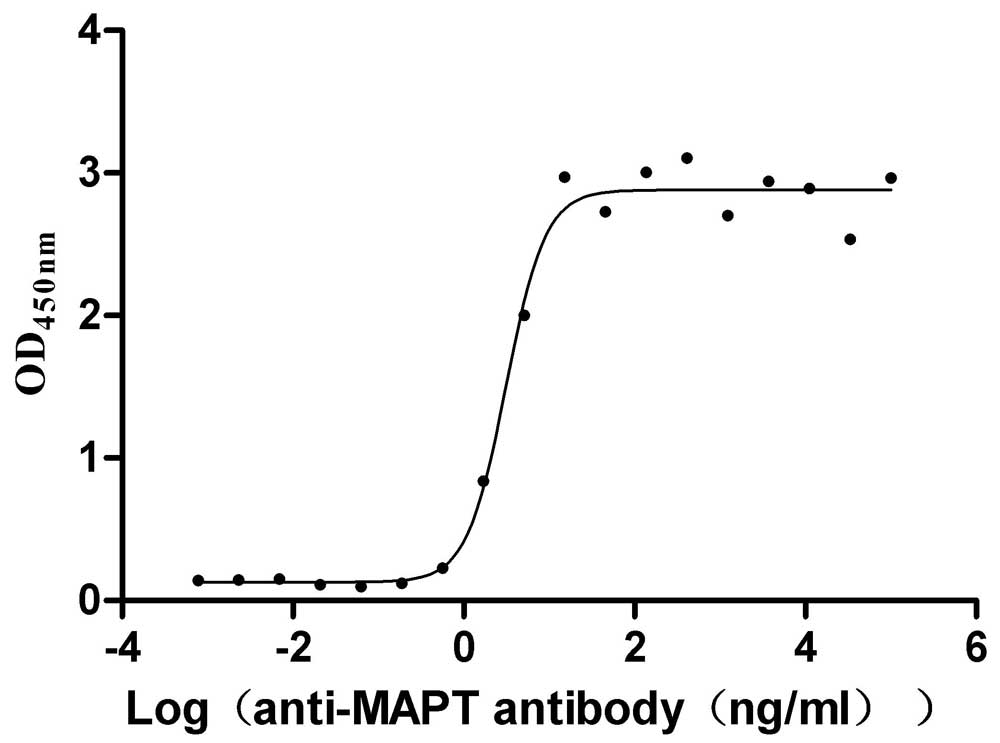Recombinant Human Fibroblast growth factor 3 (FGF3)
In Stock-
中文名称:人FGF3重组蛋白
-
货号:CSB-EP008630HU
-
规格:¥1836
-
图片:
-
其他:
产品详情
-
纯度:Greater than 85% as determined by SDS-PAGE.
-
基因名:
-
Uniprot No.:
-
种属:Homo sapiens (Human)
-
蛋白长度:Full Length of Mature Protein
-
来源:E.coli
-
分子量:32.4 kDa
-
表达区域:18-239aa
-
氨基酸序列AAGPGARLRRDAGGRGGVYEHLGGAPRRRKLYCATKYHLQLHPSGRVNGSLENSAYSILEITAVEVGIVAIRGLFSGRYLAMNKRGRLYASEHYSAECEFVERIHELGYNTYASRLYRTVSSTPGARRQPSAERLWYVSVNGKGRPRRGFKTRRTQKSSLFLPRVLDHRDHEMVRQLQSGLPRPPGKGVQPRRRRQKQSPDNLEPSHVQASRLGSQLEASAH
Note: The complete sequence including tag sequence, target protein sequence and linker sequence could be provided upon request. -
蛋白标签:N-terminal 10xHis-tagged and C-terminal Myc-tagged
-
产品提供形式:Liquid or Lyophilized powder
Note: We will preferentially ship the format that we have in stock, however, if you have any special requirement for the format, please remark your requirement when placing the order, we will prepare according to your demand. -
缓冲液:If the delivery form is liquid, the default storage buffer is Tris/PBS-based buffer, 5%-50% glycerol. If the delivery form is lyophilized powder, the buffer before lyophilization is Tris/PBS-based buffer, 6% Trehalose.
-
复溶:We recommend that this vial be briefly centrifuged prior to opening to bring the contents to the bottom. Please reconstitute protein in deionized sterile water to a concentration of 0.1-1.0 mg/mL.We recommend to add 5-50% of glycerol (final concentration) and aliquot for long-term storage at -20℃/-80℃. Our default final concentration of glycerol is 50%. Customers could use it as reference.
-
储存条件:Store at -20°C/-80°C upon receipt, aliquoting is necessary for mutiple use. Avoid repeated freeze-thaw cycles.
-
保质期:The shelf life is related to many factors, storage state, buffer ingredients, storage temperature and the stability of the protein itself.
Generally, the shelf life of liquid form is 6 months at -20°C/-80°C. The shelf life of lyophilized form is 12 months at -20°C/-80°C. -
货期:3-7 business days
-
注意事项:Repeated freezing and thawing is not recommended. Store working aliquots at 4°C for up to one week.
-
Datasheet & COA:Please contact us to get it.
相关产品
靶点详情
-
功能:Plays an important role in the regulation of embryonic development, cell proliferation, and cell differentiation. Required for normal ear development.
-
基因功能参考文献:
- FGFR1 and/or FGF3 gene amplification correlated with a lower pathologic complete response in patients with HER2(+) early breast cancer treated with neoadjuvant anti-HER2 therapy PMID: 28381415
- fibroblast growth factor receptor 3 missense mutations were identified in 5 cases of thanatophoric dysplasia PMID: 28249712
- MCF7 cells over-expressing both WNT1 and FGF3 show a 3.5-fold increase in mammosphere formation; conditioned media from these cells also promotes stem cell activity in untransfected parental MCF7 and T47D cells, as WNT1 and FGF3 are secreted factors. PMID: 26421711
- analysis provided evidence for gene-gene interaction between FGF3 (rs4980700) and PAX9 (rs2073242), increasing risk for isolated oral clefts (p = 0.0003). FGF3 is associated with oral clefts and may interact with PAX9. PMID: 24697712
- haplotypes may contribute to the tendon disease process in elite volleyball athletes PMID: 24661680
- FGF3 gene expression is altered in a human breast cancer progression model. PMID: 25333703
- Higher FGF-23 concentration was associated with LVED mass and with incident atrial fibrillation and may, in part, explain the link between chronic kidney disease and AF. PMID: 24920722
- A de novo 290 kb interstitial duplication of chromosome 11q13.3 including the FGF3 and FGF4 genes. PMID: 24120895
- tooth agenesis had increased risk of a family history of cancer. tooth agenesis was associated with positive self-reported family history of cancer and variants in FGF3. PMID: 23169889
- This study is the first to show a significant association between coronary calcification and elevated serum FGF 23 in children. PMID: 21359960
- confirm the absence of otodental syndrome in heterozygous FGF3 carriers, but report unilateral microtia in one of them PMID: 21480479
- Manifestations of recessive FGF3 mutations range from fully penetrant LAMM syndrome to deafness with residual inner ear structures and, by extension, with minimal syndromic features. PMID: 21306635
- alterations in dosage of the Fgf3 gene cause dental morphological changes PMID: 20018768
- labyrinth aplasia, microtia, and microdontia (LAMM) syndrome, caused by mutations in FGF3 PMID: 19950373
- These findings suggest that the nuclear form of FGF3 inhibits cell proliferation by interfering with ribosomal biogenesis. PMID: 16263090
- Development of the inner ear is completely disturbed at a very early stage--or the otic vesicle is not induced at all--in all of the affected individuals who carried two mutant FGF3 alleles PMID: 17236138
- FGF3, FGF7, FGF10, FGF18, and FGFR1 may have roles in nonsyndromic cleft lip and palate PMID: 17360555
- Implication of FGF3 and FADD in human craniofacial disease. PMID: 17656375
- sequenced the FGF3 gene in 10 unrelated families in which probands had congenital deafness associated with various inner ear anomalies, including Michel aplasia, with or without tooth or external ear anomalies. PMID: 18435799
- study identified a homozygous missense mutation (c.196G-->T) in FGF3 in 21 affected individuals from a large extended family phenotypically characterized by autosomal recessive syndromic congenital sensorineural deafness, microtia and microdontia PMID: 18701883
- Loss of FGFR3 signaling provides evidence that extracellular signals regulate not simply the proliferation or survival of radial glial cells, but specifically their progression to intermediate progenitor cells during neurogenesis in vivo. PMID: 19923290
收起更多
-
相关疾病:Deafness with labyrinthine aplasia, microtia and microdontia (LAMM)
-
亚细胞定位:Secreted.
-
蛋白家族:Heparin-binding growth factors family
-
数据库链接:
















